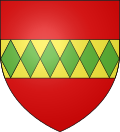Bages, Aude
Commune in Occitanie, France From Wikipedia, the free encyclopedia
Commune in Occitanie, France From Wikipedia, the free encyclopedia
Bages (French pronunciation: [baʒ] ⓘ; Occitan: Bajas) is a commune in the Aude department in the Occitanie region of southern France.
Bages | |
|---|---|
 A general view of Bages, seen from a vineyard | |
| Coordinates: 43°07′27″N 2°59′30″E | |
| Country | France |
| Region | Occitania |
| Department | Aude |
| Arrondissement | Narbonne |
| Canton | Narbonne-2 |
| Intercommunality | Grand Narbonne |
| Government | |
| • Mayor (2020–2026) | Jean-Louis Rio[1] |
Area 1 | 12.53 km2 (4.84 sq mi) |
| Population (2022)[2] | 750 |
| • Density | 60/km2 (160/sq mi) |
| Time zone | UTC+01:00 (CET) |
| • Summer (DST) | UTC+02:00 (CEST) |
| INSEE/Postal code | 11024 /11100 |
| Elevation | 0–190 m (0–623 ft) (avg. 36 m or 118 ft) |
| 1 French Land Register data, which excludes lakes, ponds, glaciers > 1 km2 (0.386 sq mi or 247 acres) and river estuaries. | |
Bages is located in the urban area of Narbonne on the Canal de la Robine and the Étang de Bages-Sigean (Bages-Sigean Lake) some 6 km south-west of Narbonne and 9 km north of Portel-des-Corbières. Access to the commune is by the D6009 road from Narbonne which passes through the centre of the commune and continues south to Salses-le-Château. Access to the village in the east of the commune is by road D105 which branches from the D6009 just north of the commune and goes to the village before continuing south to Peyriac-de-Mer. The A9 autoroute passes through the commune from north to south but has no exit in the commune. The nearest exit is Exit ![]() 38 some 4 km north of the commune which links to the D6009. Apart from the village there are the hamlets of Les Pesquis, Domaine de Java, and Prat de Cest.[3]
38 some 4 km north of the commune which links to the D6009. Apart from the village there are the hamlets of Les Pesquis, Domaine de Java, and Prat de Cest.[3]
The Étang de Bages-Sigean forms the entire eastern border of the commune with numerous streams flowing from the commune into it such as the Ruisseau Mairal, the Ruisseau de Boutoubouli, and the Ruisseau des Potences. A smaller Lake - the Étang de Saint-Paul - is on the southern border of the commune linked to the much larger Étang de Bages-Sigean with a dam forming the border of the commune.[3]
The origins of the site of the present commune date back to prehistoric times. According to historians tools found in Bages attest the presence of man from the Lower Paleolithic (80,000 years ago). Undoubtedly Neanderthal then Cro-Magnon men stayed on the shores of the Narbonne Gulf (sea at the time). The discovery of Neolithic sites proves the existence of significant human communities at that time.[5]
It was under Roman occupation that a real settlement emerged. Many plots of land were distributed to senior army veterans and there were numerous luxurious villae. The origin of the current name is thought to have come from this period: BAÏA or BAÏES in Latin meaning "place of pleasure". Few traces remain of this period and they are often covered by vegetation. The most important are those of "Castellas" and "Monadières" - important Villae from the beginning of that era.
The population of the time left the flat areas to shelter from the wind by moving to the rocky outcrop seen today. This was a slightly dominant defensive position but also the climate and exposure allowed them to live without encroaching on arable land. The Cadran Solaire (Sundial) (11th century ) marks the entrance of the old village. A corner of the Lake can be seen from the narrow and steep streets.
The village of Bages is on the edge of the lake although agriculture, especially the vineyards, forms the core of its economy (the main square of the village dates to the Revolt of the Winemakers in 1907). Bages village is mostly considered as a fishing village.
 |
The official status of the blazon remains to be determined.
Blazon:
|
| From | To | Name |
|---|---|---|
| 1870 | 1877 | Louis Daude |
| 1877 | 1878 | Guilhaume Alberny |
| 1878 | 1888 | Louis Daude |
| 1888 | 1891 | Jean Daude |
| 1891 | 1892 | Auguste Gayraud |
| 1892 | 1944 | Gabriel Cros-Mayrevieille |
| 1944 | 1945 | Joseph Martin |
| 1945 | 1977 | Louis Alberny |
| 1977 | 1983 | René Chevrier |
| 1983 | 1995 | Georges Arcis |
| 1995 | 2008 | Claude Mulero |
| 2008 | 2020 | Marie Bat |
| 2020 | 2026 | Jean-Louis Rio |
The inhabitants of the commune are known as Bageois or Bageoises in French.[7]
|
| ||||||||||||||||||||||||||||||||||||||||||||||||||||||||||||||||||||||||||||||||||||||||||||||||||||||||||||||||||
| Source: EHESS[8] and INSEE[9] | |||||||||||||||||||||||||||||||||||||||||||||||||||||||||||||||||||||||||||||||||||||||||||||||||||||||||||||||||||


Art is prominent in the commune with Painters, sculptors, visual artists, musicians, storytellers, and cabinet makers drawing inspiration. There are four permanent Art galleries: La Maison des Arts , L'Etang Art (which also has publishing activity through Les Temps d'Art Graphique), Latuvu and NullepArt.
The commune is in the zone of the Vin de pays des Coteaux du Littoral Audois (Local wine of Coteaux du Littoral Audois)
In the fishing village the main produce is eel which is prepared in bouillabaisse style.
The Church contains several items that are registered as historical objects:
Seamless Wikipedia browsing. On steroids.